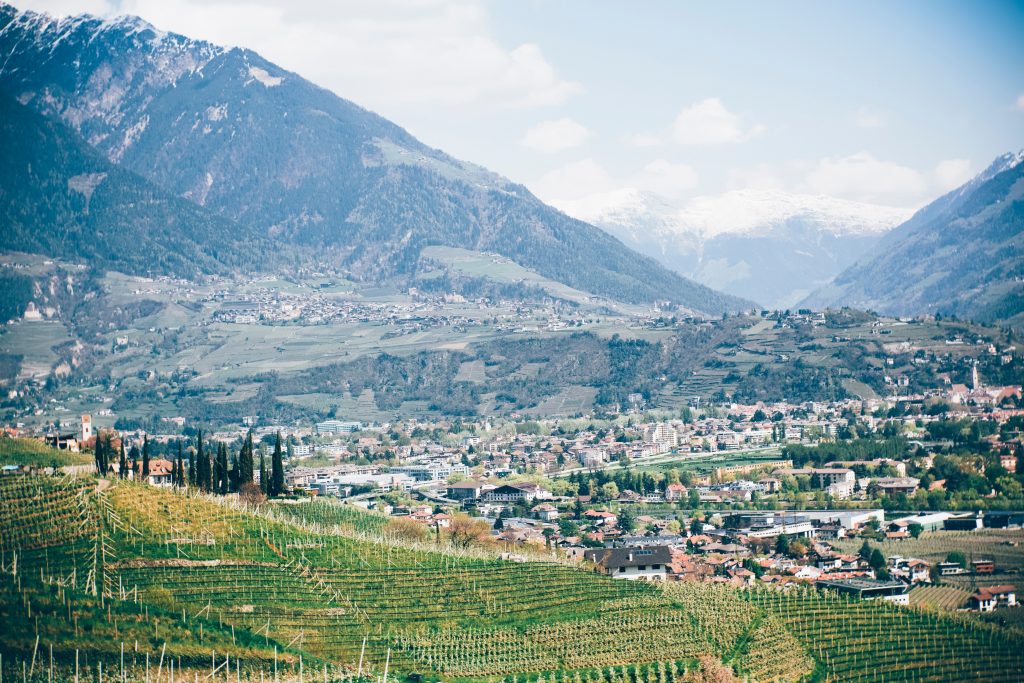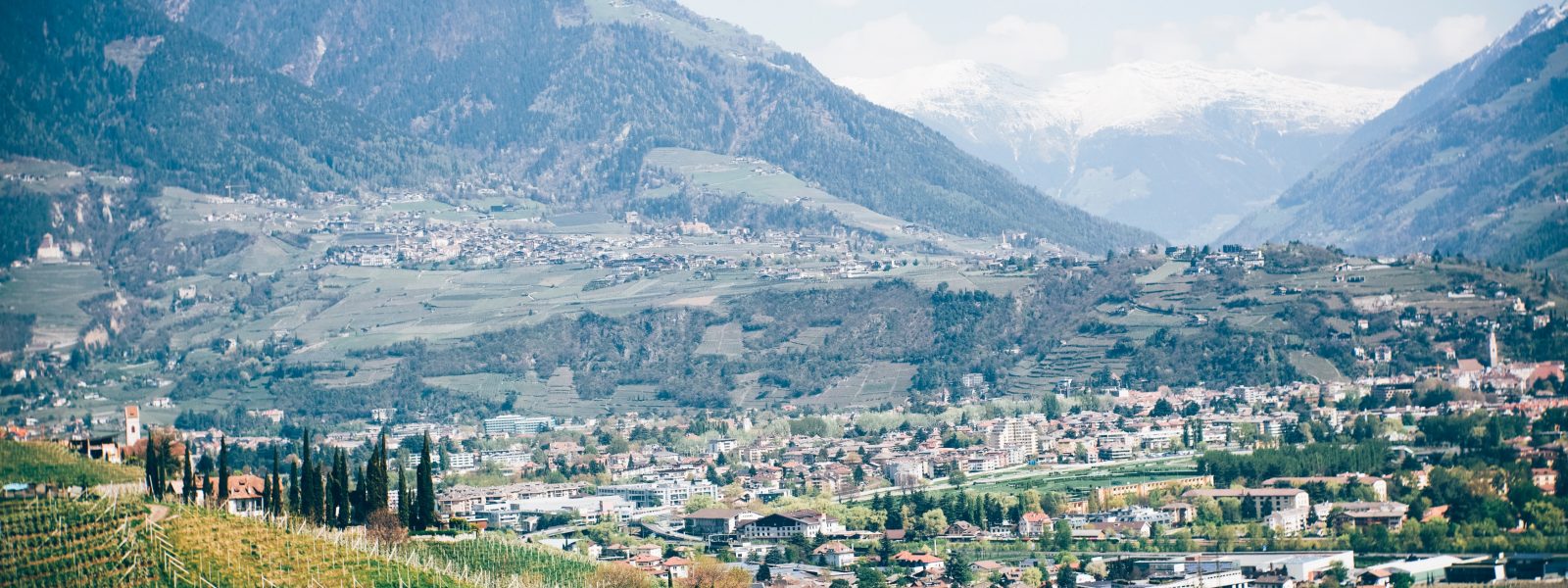Merano is an Italian municipality of 41.172 inhabitants, capital of the district community of Burgraviato, in the autonomous province of Bolzano, in Trentino- South Tyrol. After the capital Bolzano, Merano is the most populated center in the province and the third in Trentino-Alto Adige.

The spectacular landscape, high-level cuisine, countless possibilities for sport and leisure: the spa town of Merano and its surroundings are a precious gem in the heart of South Tyrol. City and nature, tradition and modernity coexist in a happy balance. Without forgetting the vocation to the well-being of these places, which finds its maximum expression in the Merano Thermal Baths.
Merano is, after the city of Bolzano, the second largest city in South Tyrol. Thanks to its geographical position, in a naturally protected basin, the area enjoys a pleasant mild climate. Here, in fact, you will find a very particular climate that favours the growth of palm trees, olive trees as well as cypresses. The magnificent alpine panorama also confers a particular charm to the city.
In the 19th century ca. Merano became known as a health resort. Scientists and doctors recommended the mild climate and the pure air of the city, which was particularly beneficial for the treatment and healing of the respiratory tract. The city also became famous and attracted many guests with its famous grape and goat milk cure.
The symbol of the city is the Kurhaus, a beautiful and important Art Nouveau building, located along the Lungopassirio promenade in the city center. But also other places of interest, such as castles or museums, can be visited. With an exciting journey to discover nature, Trauttmansdorff Castle invites you with its famous botanical garden.
Let’s start this tour in amazing Merano!
The Gardens of Trauttmansdorff Castle
The Gardens of Trauttmansdorff Castle are, not surprisingly, the most popular tourist destination in South Tyrol. Every corner of the Gardens reserves multisensory experiences, gives moments of peace and relaxation, intrigues and surprises tourists and residents alike. And there are many reasons to visit them, like their attractions.
The Gardens of Trauttmansdorff Castle in Merano, extended to slope down over a total area of 12 hectares, bring together exotic and Mediterranean landscapes in a natural amphitheatre, breath-taking views of the surrounding mountain scenery and a sun-kissed Kurstadt Merano.
In more than 80 botanical environments, plants from all over the world thrive and flourish. Young or old, botany enthusiasts or ordinary people: the Gardens of Trauttmansdorff Castle fascinate anyone with the enchanting mix of nature, culture and art. Various multisensory stations, suggestive themed gardens, artistic pavilions and specimens of the animal kingdom make the Gardens of Castel Trauttmansdorff, easily reachable on foot from Merano, a very varied and fascinating reality. The Touriseum, Provincial Museum of Tourism, hosts an unusual perspective on two centuries of tourism history in Tyrol and Merano.
The Gardens of Trauttmansdorff Castle fascinate and amaze with the incredible variety of their landscapes. 80 botanical environments spread over 12 hectares divided into 4 thematic areas: the silent Woods of the World reveal miniatures of American and Asian forests, the bright Soledeliziano Gardens with their Mediterranean charm, the typical Landscapes of South Tyrol accompany you to discover of the native vegetation and the suggestive Aquatic and Terraced Gardens present the typical architecture of European gardens, between stairways and streams of water.
A trip around the world in a few hours, immersed in distant landscapes, yet so close.
Week after week, the Gardens constantly change their face. The nature and gardeners of Trauttmansdorff, in an established partnership, do their utmost to highlight every season, reserving pleasant surprises every week.
The Tappeiner Promenade
One of the most beautiful walks in Merano and environs is undoubtedly the Tappeiner Promenade, a 4 km path that runs along the Merano Mountain (Küchelberg) about 100 m above the city. It is considered one of the most beautiful walks in Europe and offers a mix of alpine and Mediterranean vegetation, combined with a splendid panoramic view. The luxuriant vegetation with pine nuts, cedars, corks, eucalyptus, bamboo, magnolias, agave, aloe and prickly pears, gives the walk a pleasant Mediterranean atmosphere.
The Tappeiner Promenade (Tappeinerweg) originates from the parish church of Merano and ends in the Quarazze district. Thanks to the panoramic view of the city, the walk is also called the “crown” or the “grandstand” of the city of Merano. The town of cure owes this path to the doctor, botanist and anthropologist Dr. Franz Tappeiner from Lasa in Val Venosta, who also gave the walk its name. The path is flat and also suitable for strollers.
The Tappeiner walk is also known for its lush vegetation, especially the Mediterranean. The most present needle trees are domestic pine and Himalayan cedar; as regards broad-leaved trees, however, cork, olive, bagolaro, arbutus, eucalyptus, magnolia and various bamboo species should be mentioned. A sweet scent – as the name already promises – is spread by the flowers of the fragrant osmanthus. There are also palm trees from China, agaves, aloe, opuntie, alongside many flowering plants and ground cover plants.
The municipality of Merano maintains a tree register, which can be consulted online, which also lists a large part of Tappeiner plants and shrubs. A statistic in this land register lists more than 400 specimens of trees and shrubs. Along the walk these specimens present a numerical plate, so that the Tappeiner can also be used as a botanical learning path.
The walk takes its name from the one who financed it, that is the doctor, botanist and anthropologist Franz Tappeiner. Tappeiner, a native of Lasa, had opened a medical practice in Merano since 1846; thanks to his innovative methods of treatment he soon gained the trust of a high-ranking clientele, thanks to whom he had become more than well-off over the years. In 1892 he donated 22,000 florins to the city of Merano to create a panoramic route intended primarily for medical guests. In 1896 he donated an additional 5000 florins, on condition that they were used to complete the walk. The first stretch, which from Castel San Zeno reaches via Galilei, was inaugurated in 1893, the second section, up to via Verdi, in 1911. The final stretch up to Quarazze, whose construction presented the greatest technical difficulties, could be brought to accomplished only in 1928.
Merano Historic Center
The area around Merano was already settled in the Roman age and bore the name “Castrum Maiense”. Merano itself was mentioned for the first time in 857 with the name “Mairania” and in the 13th century it was proclaimed a city.
The heart of the spa town is the historic center, the oldest part of Merano as well as the most lively. Here you meet to have a drink, to wander around or to go to the theater. Most of the shops are located under the medieval arcades, built in the thirteenth century by the counts of Tyrol. With its 400 meters in length, from Piazza Grano to the square in front of the parish church of S. Nicolò, the Via dei Portici in Merano is one of the longest arcaded streets in South Tyrol.
The Lungopassirio walk invites to pleasant walks along the bank of the Passirio in all seasons of the year. In summer, along the promenade, a light refreshing breeze awaits you, while in winter you will find the famous Christmas market waiting for you. Those who go along the promenade pass through beautiful architectural constructions such as the Kurhaus. This Art Nouveau masterpiece was built in 1874. Furthermore, by crossing a bridge over the Passirio river you can also reach the well-known structure of the Merano Thermal Baths.
Merano with its arcades, a medieval shopping street that boasts 800 years of history. Its construction dates back to Mainardo II of Tirolo-Gorizia, grandfather of Margherita di Tirolo-Gorizia. Via dei Portici was built in a period in which Merano, as a newly born city, had a prosperous period of growth and was named the capital of the Hapsburg county of Tyrol. The arcades are divided into two parts: the mountain arcades (Berglauben) along the slope of the Küchelberg, and the water arcades (Wasserlauben) towards the Passirio.
The arcades (portici) of Merano, with a length of 400 meters, are the longest in Tyrol and invite to a walk, an afternoon of shopping or a coffee in the sun. The street extends from west to east, that is from Piazza del Grano to Piazza Duomo, where the Parish Church of San Nicolò rises. A variety of shops, from clothing chains to delicatessens, can be found under the arcades, while the beautiful facades of houses from different stylistic periods are equipped with erkers and arched portals. The weekly market takes place in the adjacent Corso della Libertà.
The Portici di Merano and the historic center of the spa town are surrounded by many attractions and things to see: among them the Kurhaus, built in Art Nouveau style, the suggestive promenades and the famous Merano Thermal Baths. And how do you reach Via dei Portici? The road connects Piazza del Grano to Piazza Duomo, nearby there are parking lots (for a fee) and stops for urban lines.
Rametz Castle
Rametz Castle is a medieval manor house located in Maia Alta in the municipality of Merano.
Rametz Castle stands a morainic hill in Maia Alta (Obermais) in Merano (Meran), surrounded by wonderful vineyards. Here, there is everything you could wish for: Mediterranean climate, soil rich in water, and mountains that protect the vines from the wind. Aware of this, the owners of the castle, the Schmid family, decided to cultivate the 10 hectares of land surrounding the castle as a vineyard. This little corner of paradise also includes a museum, dedicated to viticulture and established in 1980 on the ground floor and in the cellars of Castel Rametz.
Tools for cultivating the land, harvesting, vinifying and transporting are displayed in four large rooms. It is also about equipment that has been forgotten over time and that shows how grapes were transformed into wine in times gone by. There are also ancient equipment for the cultivation of wheat and for the fight against pests. In 2007, the Wine Museum was enlarged with images and tools that will make you discover how speck is produced. The visit begins with a walk through the vineyards with relative explanation of the various works that are carried out during the year among the vineyards. After that, we continue in the ancient eighteenth-century cellar, and end at the modern wine cellar, where you can taste wine and Kaiserspeck.
The first historical information concerning the castle dates back to 1269, when it was mentioned for the first time in written documents. Between the XIV and XV century it was owned by the Rametz family, then passed to the Aichner family, then to the Quaranta, Planta, Travers and Parravicini families.
In 1836 it was purchased by Francesco Flarer, professor at the University of Pavia, whose daughter married Agostino Depretis. He transformed it into his home, carrying out a radical restoration which brought the castle to its current appearance, characterized by Ghibelline turrets and battlements.
During World War II it was requisitioned by German troops together with Castel Labers and used as a logistic base for Operation Bernhard.
Remetz Castle also includes a wine shop, the “House of Wine” in Tyrol and a restaurant. In 2018, three Castel Monreale sparkling wines from Castel Rametz were awarded the “The WineHunter Award”. The the castle is also known as a venue for events, both private and public, such as the Advent.
In 1954, the Austrian writer Fritz von Herzmanovsky-Orlando died there.
It is currently home to a renowned winery with a restaurant and a small wine museum created in the rooms of the castle, especially Pinot. The rest of the manor is not normally open to visitors.
Merano Thermal Baths
Design jewel nestled in the heart of the city, Merano Thermal Baths are the only spa in South Tyrol in such a central position. The steel and glass cube embellished with warm wooden elements fits into the surrounding environment in perfect harmony. The five-hectare park extends all around, much appreciated especially in summer for the tree-lined corners where you can find some refreshment.
Merano Thermal Baths offer different types of saunas: three steam baths (one of which is located in the spa park), the bio hay sauna, the caldarium for inhalations with saline water and the Finnish sauna located in an outdoor house. With temperatures ranging from 40 to 100 degrees, well-being – and beauty – are guaranteed
The Spa of the Merano Thermal Baths offers a wide range of exclusive treatments such as malt and hop peeling, massages with hot herbal tampons and a bath in buttermilk, the latter much loved by Empress Sissi. Some centuries ago, Merano established itself as a renowned climatic health resort in South Tyrol, chosen by many European nobles and scholars such as Kafka, Zweig and Morgenstern for stays of cure. Equally wide is the offer of medical treatments that offers inhalations with thermal water, therapeutic baths and physiotherapy.
The teachings of the Bavarian shepherd and hydro therapist Sebastian Kneipp still enjoy great popularity in South Tyrol. Since the 19th century, therapies and spa treatments have been offered in the surroundings of Merano.
The outdoor pool of the Merano Thermal Baths is probably one of the most well-kept outdoor pools in South Tyrol and features a path with a Kneipp pool. A few minutes from the center of the village of Prissiano, there is another modern Kneipp facility. After their walk in the water, guests can relax on the benches and listen to the roar of the waterfall.
The Powder Tower of Merano
The Powder Tower or Powder Tower is a South Tyrolean historical military architecture located in the municipality of Merano.
The tower, originally had an exclusively military function, was flanked in the 14th century by the palace, today it is documented only by a sketch of the Brandis Code. Its double-walled structure, of which the internal one is in opus spicatum (type of floor with bricks arranged in a herringbone pattern spread by the Romans), has advanced the hypothesis of a much older origin that would date back to Roman age.
Even the position, on a rocky relief at the entrance of the Val Passiria, in close proximity to the Maiense castrum on which Zenoburgs was built, would confirm its remote antiquity. With the abandonment of the castles of Tyrol and Merano by the Habsburgs, the castle quickly declined, and the tower remained standing, which was connected to the fortified walls of Merano at the time of its expansion at the beginning of the 1600s, through a wall whose remains are still visible next to the Porta Passiria. The tower was destined to store dust and took the name of Torre Polveriera (Pulverturm).
The Powder Tower is rightly considered one of the most popular tourist attractions in Merano. This tower owes its name to the fact that the fathers of the city of Merano, worried about the large amount of gunpowder stored in the city during the Thirty Years War, had kept it in the keep of Castel Ortenstein. The castle was demolished, fortunately the tower was not demolished!
Today, the tower is accessed via a staircase in its internal courtyard and its 20-meter-high panoramic platform offers a fabulous view of the center of Merano and the whole Burgraviato.
If you look from the tower towards the Porta Passiro, you can immediately recognize the well-preserved remains of the ancient city walls of Merano.
Princely Castle of Merano
The Princely Castle is a castle located in the historic center of Merano: throughout its history it has always been used as a dwelling, until it became a small museum center.
The construction of some cellars began during the mid-fifteenth century: it was only from 1470 that the castle was built , in the center of Merano, at the foot of Mount Benedetto, at the behest of Duke Sigismondo of Austria, called “il danaroso”, as a private home. During the course of the sixteenth century, the structure continued to perform its function as a noble residence, so much so that inside it, in 1516 the emperor Maximilian I stayed ; over the years, however, with several changes of owners, it slowly fell into disrepair and some documents show that in the seventeenth century only the chapel was used for the celebration of religious services.
During the Napoleonic wars, it passed under the control of the Baverese government which ceded it as compensation to the Thurn und Taxis princes, who used it as administrative headquarters. In 1815, the building was purchased by the municipality of Merano, which intended to demolish it to make room for a school: protests by citizens, with a popular petition, avoided its demolition and from 1878 to 1880 the castle was object of restoration works, carried out by the architect Friedrich von Schmidt, making it take on a late Gothic aspect and furnished with furniture, including some chests, weapons and paintings, typical of the period of its construction; in 1880 it was reopened to the public.
With its wedding rooms and the original “stube”, the museum of the Princely Castle of Merano offers a precious opportunity to study habits and ways of life of the late Middle Ages.
Ancient tiled stoves, frescoes, musical instruments and weapons revive the glories of an era that has long since passed. Couples who marry in a civil ceremony in Merano can choose between a municipal hall or the beautiful Princely Castle.
With its twenty thousand visitors a year, the castle turns out to be one of the best preserved in the whole of South Tyrol and is also used for the celebration of weddings with civil ceremony.





